#Calothorax lucifer
Photo

“If I tilt my head way back like this, now can you see my pretty chin?”
Lucifer hummingbird / colibrí lucifer (Calothorax lucifer) at Ash Canyon Bird Sanctuary, Cochise County, Arizona.
#photographers on tumblr#bird#hummngbird#lucifer hummingbird#Calothorax lucifer#Ash Canyon Bird Sanctuary#Southeastern Arizona Bird Observatory#Cochise County#Arizona
152 notes
·
View notes
Text
Animal of the Day!
Lucifer Sheartail (Calothorax lucifer)
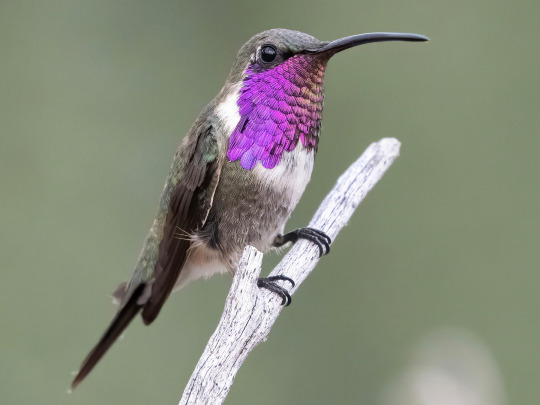
(Photo by Marky Mutchler)
Conservation Status- Least Concern
Habitat- Southwestern United States, Northern Mexico
Size (Weight/Length)- 10 cm
Diet- Nectar; Insects
Cool Facts- The lucifer sheartail hummingbird is an expert of the arid desert. They contribute to pollination of agave plants and desert wildflowers as they seek out nectar. Males are highly territorial and chase off birds several times larger than themselves. During the breeding season, male lucifer sheartails put on a dazzling display. They hover several dozen meters above the ground and then dive at full velocity, their tail making a distinct snapping noise. The female raises the chicks by herself, incubating the eggs for only 15 days. The chicks fledge in a little under a month and set off to find their own territory full of flowers.
Rating- 13/10 (Named for being ‘light-bearing’.)
#animal of the day#animals#birds#hummingbirds#wednesday#november 1#lucifer sheartail#biology#science#conservation#the more you know
181 notes
·
View notes
Photo

A female Lucifer Hummingbird (Calothorax lucifer), Christmas Mountains, Brewster County, Texas.
155 notes
·
View notes
Text
Fwd: Conference: Online.AgavoideaeGenomics.Jun13
Begin forwarded message: > From: [email protected] > Subject: Conference: Online.AgavoideaeGenomics.Jun13 > Date: 20 May 2022 at 06:56:19 BST > To: [email protected] > > > Dear Colleagues: > > Instituto de Ecología at Universidad Nacional Autónoma de México > (UNAM) is happy to announce the Agavoideae Conference and Bioinformatics > Workshop. On June 13, 2022 researchers from throughout the Americas > will present their research describing the ecology, evolution, and > physiology of plants in the Agavoideae, and how genomic approaches > are being harnessed to address research questions in this group. The > workshop was made possible through generous support from the American > Genetic Association. > > To register to attend by zoom, please complete the following Google Form: > > https://ift.tt/kuLerbY > > Time Title Speaker > 10:00 - 10:25 AM Evolutionary biology, diversity, pollination and genomics > of agave, yucca and their relatives. Luis Eguiarte (UNAM) > 10:30 - 10:55 AM Genomic studies of the Asparagaceae Jim Leebens Mack > (University of Georgia) > 11:00 - 11:25 AM Phylogenomics of the Agavoideae Michael McKain (University > of Alabama) > 11:25 - 11:40 AM Break > 11:40 - 11:55 AM Phylogeny and morphological evolution of Yucca > (Agavoideae, Asparagaceae) Maria Magdalena Ayala (FES Zaragoza, UNAM) > Co-authors: Marie-Stephanie Samain, Shannon D. Fehlberg, R. García-Sandoval > and Abisai García-Mendoza > 12:00 - 12:15 PM Hibridación entre Yuccas endémicas de la península de Baja > California Maria Clara Arteaga (Centro de Investigación Científica y de > Educación Superior de Ensenada, Baja California) > 12:20 - 12:35 PM Evolución de señales volátiles en el género Yucca > Evolution of volatile signals in the genus Yucca Rob Raguso (Cornell > University) > 12:35 - 1:45 PM Lunch > 1:45 - 2:00 PM Abiotic and biological defense mechanisms in Agave Jorge > Nieto Sotelo (UNAM) > 2:05 - 2:20 PM Evolution of CAM photosynthesis in the Agavoideae Karolina > Heyduk (University of Hawai'i) > 2:25 - 2:50 PM Genomics of the Agave’s Pollinator Lucifer Hummingbird / > Genómica evolutiva de Calothorax lucifer: un colibrí polinizador de > Agaves. Yuyini > Licona-Vera (UNAM) > 2:50 - 3:05 PM Break > 3:05 - 3:20 PM Insights from Chloroplast Phylogenomics on the Origin of > Relictual Agave Domesticates in Arizona, U.S.A. Andrew Salywon (Desert > Botanical Garden) > 3:25 - 3:40 PM Natural History and Conservation of Yucca queretaroensis Fabiola > Magallán Hernández (Universidad Autónoma de Querétaro) > 3:40 - 3:55 PM Age of Yucca and The Yucca queretaroensis problem Christopher > Irwin Smith (Willamette University) > 4:30 - 6:00 PM Student Lightning Talks > > > *Christopher Irwin Smith* > *He/His/Him (Or any respectful pronouns)* > Professor of Biology > Willamette University > Salem, OR 97301 > ph: 503-370-6181 > fax: 503-375-5425 > Make an appointment: Google Calendar > > > *Joshua Tree Genome Project:* > JoshuaTreeGenome.org > Watch the Joshua Tree Genome Project Documentary on Great Big Story > > > Christopher Smith >
via IFTTT
0 notes
Text
You’ve heard of the Satanic Nightjar, now get ready for...
Lucifer Hummingbird (Calothorax lucifer)
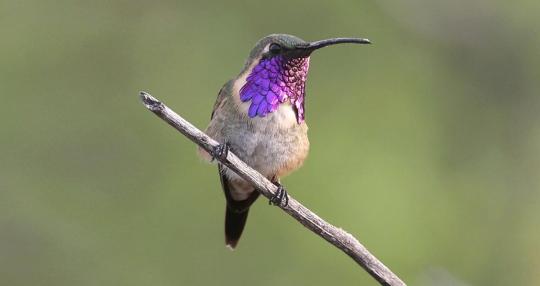
Also known as Lucifer Sheartail because of the shape of their tails. They live in northern Mexico and a little bit of the southwestern U.S. They prefer dry or desert habitats at high altitudes. They migrate to central Mexico in the winter. Only the males have the shiny purple throats like the one pictured above.
Unlike the Satanic Nightjar, the Lucifer Hummingbird doesn’t really have a cool creepy backstory as the origin for its name. It most likely got its’ name from the original Latin meaning of “lucifer” which just meant “light-bearing”. (x, y)
#birds#hummingbird#lucifer hummingbird#calothorax lucifer#caprimulgiformes#apodiformes#trochilidae#animals
8 notes
·
View notes
Text
Calothorax

Lucifer Hummingbird by Greg Schechter, CC BY 2.0
Etymology: Beautiful Breast
First Described By: Gould, 1859
Classification: Dinosauromorpha, Dinosauriformes, Dracohors, Dinosauria, Saurischia, Eusaurischia, Theropoda, Neotheropoda, Averostra, Tetanurae, Orionides, Avetheropoda, Coelurosauria, Tyrannoraptora, Maniraptoromorpha, Maniraptoriformes, Maniraptora, Pennaraptora, Paraves, Eumaniraptora, Averaptora, Avialae, Euavialae, Avebrevicauda, Pygostaylia, Ornithothoraces, Euornithes, Ornithuromorpha, Ornithurae, Neornithes, Neognathae, Neoaves, Strisores, Daedalornithes, Apodiformes, Trochilidae, Trochilinae
Referred Species: C. pulcher (Beautiful Hummingbird), C. lucifer (Lucifer Hummingbird)
Status: Extant, Least Concern
Time and Place: Within the last 10,000 years, in the Holocene of the Quaternary


The Lucifer and Beautiful Hummingbirds are known entirely from Mexico, though the Lucifer Hummingbird does creep into the southwestern corner of the United States

Physical Description: Calothorax is a genus of hummingbirds, small dinosaurs that essentially convergently with insects. Calothorax ranges from 8 to 10 centimeters in length. Like most Hummingbirds, it has an ovular body, a small head, and a very long, skinny bill. The bodies of Calothorax are green in both sexes. The males have bright purple patches on their throats, while the females have orange splotches across their bellies and under their wings. Both have white patches along their throats and breasts. The females also have generally shorter bills. They have short, triangular wings for hovering, and tiny tail feathers.

Beautiful Hummingbird by Michael Retter
Diet: Like most hummingbirds, Calothorax feeds on nectar taken from flowers such as the Penstemon, Sierra Woolly Indian Paintbrush, Big Bend Anisacanthus, Yellow-Flowered Century Plant, and a variety of other flowers from cacti, grasses, and brushes. They do supplement their diet with flies.
Behavior: These birds hover near sources of nectar and use their long beaks to reach into the petals of the flower. They move their wings so fast that they are able to over, an ability that birds are not usually able to achieve. This also means that they have very strong chest muscles and extremely rapidly pumping hearts to help power this high-intensity movement. These birds make repeated, high-pitched squeaky tweets, as well as faint chirps and rattles. The wings themselves make hums like the wings of bees while they hover.
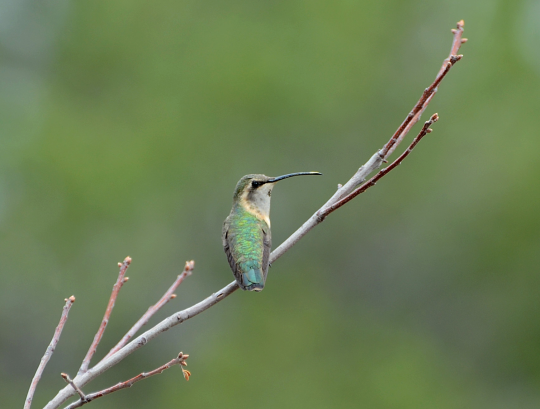
Lucifer Sheartail by Geoff Gallic, CC BY 2.0
The males, when wanting to mate with a female, will move back and forth in a horizontal hovering line. He then goes high up, before diving suddenly before her. The male then spreads his forked tail, making wacky calls to attract her. These birds breed from April through August, starting the breeding season later in the year the farther south they live. They tend to group their nests together, placing them on rocky slopes near streams, and built out of river-associated plants. They lay two small, white eggs, which are incubated by the female for two weeks, before spending three more weeks in the nest. The young birds then stay near the mother for three more weeks, where they can still be fed by the mother.
The Lucifer Hummingbird move across Mexico and into the United States based on the change of the dry and wet season, though some do remain in one spot. The Beautiful Hummingbird does not migrate.
Ecosystem: These birds live in arid and tropical scrub forest, usually at fairly higher elevations.
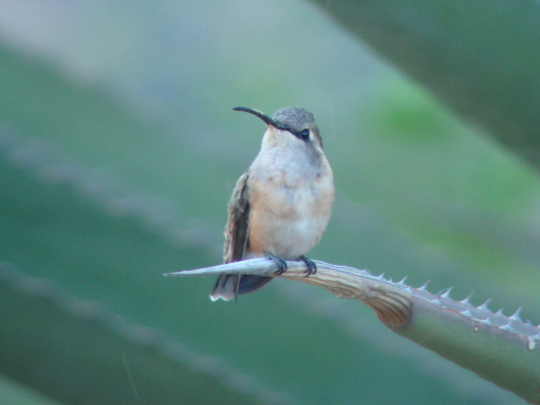
Lucifer Hummingbird by Caleb Putnam, CC BY 2.0
Other: These birds are not threatened due to a large range of foraging and breeding habitats, though the Beautiful Hummingbird is not as well known as the Lucifer Hummingbird.
Species Differences: The Lucifer and Beautiful Hummingbirds are virtually identical, and mainly differ in that the Lucifer Hummingbird is on average larger than the Beautiful Hummingbird - by a single centimeter - and also has a significantly larger range. Not to mention, the Beautiful Hummingbird remains confined in southern Mexico, while the Lucifer Hummingbird migrates from southern Mexico in the winter to northern Mexico and the southwestern United States in the summer.
~ By Meig Dickson
Sources under the cut
Jobling, J. A. 2010. The Helm Dictionary of Scientific Bird Names. Christopher Helm Publishing, A&C Black Publishers Ltd, London.
Prum, R.O. et al. 2015. A comprehensive phylogeny of birds (Aves) using targeted next-generation DNA sequencing. Nature 526: 569–573.
Scott, P.E. & Boesman, P. (2019). Beautiful Hummingbird (Calothorax pulcher). In: del Hoyo, J., Elliott, A., Sargatal, J., Christie, D.A. & de Juana, E. (eds.). Handbook of the Birds of the World Alive. Lynx Edicions, Barcelona.
Scott, P.E. & Boesman, P. (2019). Lucifer Hummingbird (Calothorax lucifer). In: del Hoyo, J., Elliott, A., Sargatal, J., Christie, D.A. & de Juana, E. (eds.). Handbook of the Birds of the World Alive. Lynx Edicions, Barcelona.
#calothorax#hummingbird#bird#dinosaur#birblr#calothorax pulcher#calothorax lucifer#beautiful hummingbird#lucifer hummingbird#birds#dinosaurs#quaternary#north america#nectarivore#flying friday#strisorian
84 notes
·
View notes
Note
Does Calothorax lucifer mean Lucifer's beautiful breast?
I’d consider that a valid translation. It sounds lewd, but “breast” can also be used to refer to the chest region in general (and of course that’s generally the intended meaning when applied to birds).
1 note
·
View note
Link
0 notes
Photo

“Calothorax lucifer” Colibrí lucifer* . . . . . . . . . . . . . . . #photography #photographer #photo #photoshoot #photoshop #photographylovers #photoshooting #bird #birds #birdphotography #birdsofinstagram #birds_captures #birdsofprey #birdwatching #birdlovers #birdingphotography #colibri #colobrí #colibries #colibríes #colibris #cameraraw #canonphotography #canon #canon📷 #canonmexico #canonméxico #colibrílucifer #wildlife #wildlifephotography https://www.instagram.com/p/CBENZV7h_4j/?igshid=1aj7rs141hg3p
#photography#photographer#photo#photoshoot#photoshop#photographylovers#photoshooting#bird#birds#birdphotography#birdsofinstagram#birds_captures#birdsofprey#birdwatching#birdlovers#birdingphotography#colibri#colobrí#colibries#colibríes#colibris#cameraraw#canonphotography#canon#canon📷#canonmexico#canonméxico#colibrílucifer#wildlife#wildlifephotography
0 notes
Photo

Calothorax lucifer / Colibrí lucifer 🍃 . . . . . . . #mexico #nature #birding #pajareando #instanimals #fotografiadeaves #colibri #fotografia #naturaleza #birds #instagram #biodiversidadmexicana #aves #photooftheday #instanature #fotodeldía #biodiversity #recomiendo #puebla #lovenature #muyinteresante #nikon #naturelover #color #hermoso (en Jardin Botanico "Helia Bravo Hollis") https://www.instagram.com/p/B0y1pusnl_E/?igshid=1ezzau1xgxl4d
#mexico#nature#birding#pajareando#instanimals#fotografiadeaves#colibri#fotografia#naturaleza#birds#instagram#biodiversidadmexicana#aves#photooftheday#instanature#fotodeldía#biodiversity#recomiendo#puebla#lovenature#muyinteresante#nikon#naturelover#color#hermoso
0 notes
Photo
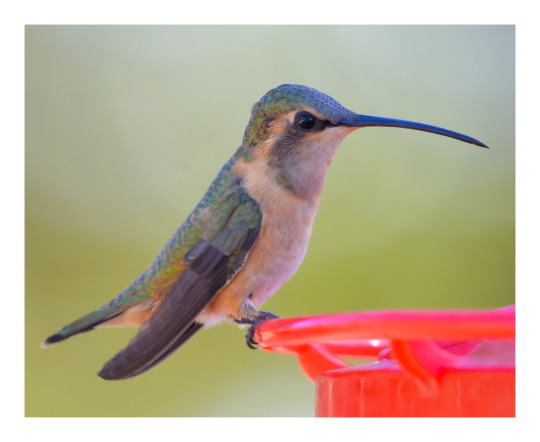
Recent birds: Female Lucifer hummingbird / colibrí lucifer (Calothorax lucifer) at an Ash Canyon feeder.
People are dazzled by the male Lucifer’s astonishing colors, but I have come to appreciate the delicate coloring of the tiny females even more.
Please click the photo for an enlarged view.
#photographers on tumblr#Lucifer hummingbird#hummingbird#bird#Calothorax lucifer#Ash Canyon Bird Sanctuary#Southeastern Arizona Bird Observatory#Cochise County#Arizona
132 notes
·
View notes
Note
“What kind of bird do you think that one is?”
“That one is a Calothorax lucifer or a Lucifer Hummingbird. It’s a male one too. You can tell by the shiny magenta feathers around its throat. The females have white feathers there.” Laural said matter-of-factly. He didn’t even have to open the bird watching book he had brought with him to the meadow. The birds here were pretty common and he knew almost every species that nested here by heart.
4 notes
·
View notes
Photo
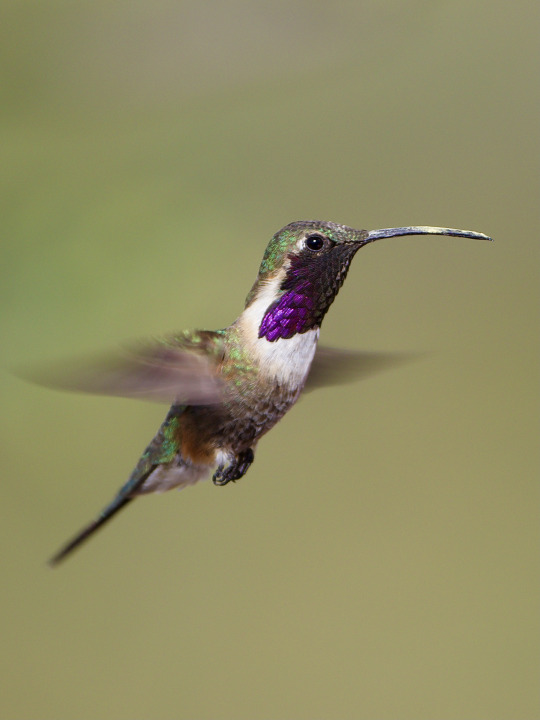
Lucifer Hummingbird (Calothorax lucifer), Christmas Mountains, Brewster County, Texas.
229 notes
·
View notes
Video
lucifer hummingbird by hawk person
Via Flickr:
Ash Canyon, AZ
27 notes
·
View notes


